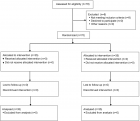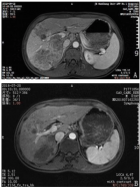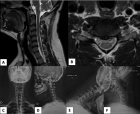Abstract
Research Article
P wave dispersion in patients with premenstrual dysphoric disorder
Seyda Yavuzkir, Suna Aydin*, Melike Baspinar, Sevda Korkmaz, Murad Atmaca, Rulin Deniz, Yakup Baykus and Mustafa Yavuzkir
Published: 31 July, 2019 | Volume 4 - Issue 2 | Pages: 090-093
Background: Growing evidence has revealed that fear and anxiety related situations could affect cardiac parameters. P wave dispersion (Pd) is an important index. In the present study, we aimed to evaluate Pd values in patients with premenstrual dysphoric disorder.
Methods: The study was composed of twenty-five female patients with premenstrual dysphoric disorder and same number of healthy controls. Pd, Pmin and Pmax values were determined by electrocardiogram (ECG) in the subjects.
Results: It was found that patients with premenstrual dysphoric disorder had considerably higher Pmax and Pmin values compared to those of healthy subjects. Pd was also significantly higher in patients with premenstrual dysphoric disorders than that of healthy subjects.
Conclusion: Study suggests that patients with premenstrual dysphoric disorder seems to have increased Pd, as can be seen in anxiety and fear related clinical conditions, considering that this group of patients have an increased trend to cardiac abnormalities, particularly cardiac arrythmias. To access strong conclusion, it is required novel studies with larger samples.
Read Full Article HTML DOI: 10.29328/journal.jccm.1001046 Cite this Article Read Full Article PDF
Keywords:
P wave dispersion; Pd: Premenstrual dysphoric disorder; ECG
References
- Pearlstein T, Stone BA. Premenstrual syndrome. Psychiatr Clin North Am. 1998; 21: 577-590. PubMed: https://www.ncbi.nlm.nih.gov/pubmed/9774797
- Herzog AG, Smithson SD, Fowler KM, Krishnamurthy KB, Sundstrom D, et al. Premenstrual dysphoric disorder in women with epilepsy: relationships to potential epileptic, antiepileptic drug, and reproductive endocrine factors. Epilepsy Behav. 2011; 21: 391-396. PubMed: https://www.ncbi.nlm.nih.gov/pubmed/21724471
- Emans SJ, Laufer MR, Goldstein DP. Premenstrual syndrome. Pediatric and Adolescent Gynecology, 5th ed. Philadelphia, PA: Lippincott-Raven Inc. 2005.
- Frasure-Smith N, Lesperance F, Talajic M. Depression following myocardial infarction. Impact on 6-month survival. JAMA. 1993; 270: 1819-1825. PubMed: https://www.ncbi.nlm.nih.gov/pubmed/8411525
- Herman JP, McKlveen JM, Ghosal S, Kopp B, Wulsin A, et al. Regulation of the hypothalamic-pituitary-adrenocortical stress response. Simple electrocardiographic markers for the prediction of paroxysmal idiopathic atrial fibrillation. Compr Physiol. 2016; 6: 603-621. PubMed: https://www.ncbi.nlm.nih.gov/pubmed/27065163
- Whirledge S, Cidlowski JA. A Role for Glucocorticoids in Stress-Impaired Reproduction: Beyond the Hypothalamus and Pituitary. Endocrinology. 2013; 154: 4450-4468. PubMed: https://www.ncbi.nlm.nih.gov/pubmed/24064362
- Remme WJ. The sympathetic nervous system and ischaemic heart disease. Eur Heart J. 1998; 19: F62-F71. PubMed: https://www.ncbi.nlm.nih.gov/pubmed/9651738
- Podr?d PJ, Kowey PR Cardiac Arrhythmia, Mechanisms, Diagnosis& Management. 2nd ed. Philadelphia, PA: Lippincott Williams&Wilkins. 2001.
- Dilaveris PE, Gialafos EJ, Sideris SK, Theopistou AM, Andrikopoulos GK, et al. Simple electrocardiographic markers for the prediction of paroxysmal idiopathic atrial fibrillation. Am Heart J. 1998; 135: 733-738. PubMed: https://www.ncbi.nlm.nih.gov/pubmed/9588401
- Dilaveris PE, Gialafos JE. P-wave duration and dispersion analysis: methodological considerations. Circulation. 2001; 103: E111. PubMed: https://www.ncbi.nlm.nih.gov/pubmed/11382743
- Nahshoni E, Gur S, Marom S, Levin JB, Weizman A, et al. QT dispersion in patients with social phobia. J Affect Disord. 2004; 78: 21-26. PubMed: https://www.ncbi.nlm.nih.gov/pubmed/14672793
- Yavuzkir M, Atmaca M, Dagli N, Balin M, Karaca I, et al. P-wave dispersion in panic disorder. Psychosom Med. 2007; 69: 344-347. PubMed: https://www.ncbi.nlm.nih.gov/pubmed/17510287
- Yavuzkir MF, Atmaca M, Gurok MG, Adiyaman S. P wave dispersion in obsessive-compulsive disorder. Indian J Psychiatry. 2015; 57: 196-199. PubMed: https://www.ncbi.nlm.nih.gov/pmc/articles/PMC4462790
- Atmaca M, Korkmaz H, Korkmaz S. P wave dispersion in patients with hypochondriasis. Neurosci Lett. 2010; 485: 148-150. PubMed: https://www.ncbi.nlm.nih.gov/pubmed/20813155
Figures:
Similar Articles
-
Value of electrocardiographic T wave inversion in lead aVL in prediction of Mid Left Anterior Descending Stenosis in patients with stable Coronary Artery diseaseGehan Magdy*,Awad Yousef. Value of electrocardiographic T wave inversion in lead aVL in prediction of Mid Left Anterior Descending Stenosis in patients with stable Coronary Artery disease. . 2017 doi: 10.29328/journal.jccm.1001015; 2: 056-062
-
Acute viral myocarditis due to Influenza H3N2 infection resembling an acute coronary syndrome: A case reportCarlos Jesus Rodriguez-Zuñiga*,Leonel Martínez-Ramírez,Carlos Alberto Guizar-Sanchez,Mauricio Quetzal Trejo-Mondragon,Nilda Espinola-Zavaleta. Acute viral myocarditis due to Influenza H3N2 infection resembling an acute coronary syndrome: A case report. . 2019 doi: 10.29328/journal.jccm.1001039; 4: 041-042
-
C-reactive protein is associated with ventricular repolarization dispersion among patients with metabolic syndromeYlber Jani*,Atila Rexhepi,Bekim Pocesta,Ahmet Kamberi,Fatmir Ferati,Sotiraq Xhunga, Artur Serani,Dali Lala,Agim Zeqiri,Arben Mirto. C-reactive protein is associated with ventricular repolarization dispersion among patients with metabolic syndrome. . 2019 doi: 10.29328/journal.jccm.1001040; 4: 043-052
-
P wave dispersion in patients with premenstrual dysphoric disorderSeyda Yavuzkir,Suna Aydin*,Melike Baspinar,Sevda Korkmaz,Murad Atmaca,Rulin Deniz,Yakup Baykus,Mustafa Yavuzkir. P wave dispersion in patients with premenstrual dysphoric disorder. . 2019 doi: 10.29328/journal.jccm.1001046; 4: 090-093
-
Aortic dissection causing 2 myocardial infarctionsSebastian Szabo*,Hans Martin Hoffmeister. Aortic dissection causing 2 myocardial infarctions. . 2019 doi: 10.29328/journal.jccm.1001074; 4: 233-235
-
Localization of the occluded vessel in acute myocardial infarctionSamir Rafla*,Amr Kamal. Localization of the occluded vessel in acute myocardial infarction. . 2020 doi: 10.29328/journal.jccm.1001082; 5: 029-033
-
ECG interpretation and commentarySamir Rafla*,Ahmed Mokhtar,Amr Kamal. ECG interpretation and commentary. . 2020 doi: 10.29328/journal.jccm.1001083; 5: 034-041
-
An unusual presentation of atrioventricular nodal reentrant tachycardiaMihaela Grecu*,Florina-Adriana Ghitun,Stefan Ailoaei,Dan Ursu,Raluca Chistol,Grigore Tinica,Cristian Statescu. An unusual presentation of atrioventricular nodal reentrant tachycardia. . 2021 doi: 10.29328/journal.jccm.1001110; 6: 014-018
-
A Wolff-Parkinson-White (WPW) Electrocardiographic Pattern in Asymptomatic Patient – State-of-the-Art-ReviewVijay Yadav*,Sanjeev Thapa,Ratna Mani Gajurel,Chandra Mani Poudel,Bhawani Manandhar,Manju Sharma,Suman Adhikari,Suraj Shrestha. A Wolff-Parkinson-White (WPW) Electrocardiographic Pattern in Asymptomatic Patient – State-of-the-Art-Review. . 2022 doi: 10.29328/journal.jccm.1001132; 7: 046-053
-
Single-center experience in sutureless aortic valve implantation using two aortic valve prosthesesLaura Rings,Vasileios Ntinopoulos,Stak Dushaj,Gojart Hoti,Philine Fleckenstein,Omer Dzemali*,Achim Häussler#. Single-center experience in sutureless aortic valve implantation using two aortic valve prostheses. . 2022 doi: 10.29328/journal.jccm.1001134; 7: 056-060
Recently Viewed
-
Psychosis in Parkinson’s Disease and Current Management Trends- an Updated Review of LiteratureRajib Dutta*. Psychosis in Parkinson’s Disease and Current Management Trends- an Updated Review of Literature. J Neurosci Neurol Disord. 2023: doi: 10.29328/journal.jnnd.1001078; 7: 027057
-
Enhancing adipose stem cell chondrogenesis: A study on the roles of dexamethasone, transforming growth factor β3 and ascorbate supplements and their combinationBernard J Van Wie*,Arshan Nazempour##,Chrystal R Quisenberry##,Nehal I Abu-Lail. Enhancing adipose stem cell chondrogenesis: A study on the roles of dexamethasone, transforming growth factor β3 and ascorbate supplements and their combination. J Stem Cell Ther Transplant. 2017: doi: 10.29328/journal.jsctt.1001004; 1: 028-051
-
Sinonasal Myxoma Extending into the Orbit in a 4-Year Old: A Case PresentationJulian A Purrinos*, Ramzi Younis. Sinonasal Myxoma Extending into the Orbit in a 4-Year Old: A Case Presentation. Arch Case Rep. 2024: doi: 10.29328/journal.acr.1001099; 8: 075-077
-
Response of Chemical Fertilisation on Six-year-old Oil Palm Production in Shambillo-Padre Abad- UcayaliEfraín David Esteban Nolberto, Guillermo Gomer Cotrina Cabello*, Robert Rafael-Rutte, Jorge Luis Bringas Salvador, Mag. Carmen Luisa Aquije Dapozzo, Guillermo Vilchez Ochoa, Luis Alfredo Zúñiga Fiestas, Nancy Ochoa Sotomayor, Mg. Merici Medina Guerre. Response of Chemical Fertilisation on Six-year-old Oil Palm Production in Shambillo-Padre Abad- Ucayali. Arch Food Nutr Sci. 2024: doi: 10.29328/journal.afns.1001058; 8: 024-028
-
Forensic analysis of private browsing mechanisms: Tracing internet activitiesHasan Fayyad-Kazan*,Sondos Kassem-Moussa,Hussin J Hejase,Ale J Hejase. Forensic analysis of private browsing mechanisms: Tracing internet activities. J Forensic Sci Res. 2021: doi: 10.29328/journal.jfsr.1001022; 5: 012-019
Most Viewed
-
Evaluation of Biostimulants Based on Recovered Protein Hydrolysates from Animal By-products as Plant Growth EnhancersH Pérez-Aguilar*, M Lacruz-Asaro, F Arán-Ais. Evaluation of Biostimulants Based on Recovered Protein Hydrolysates from Animal By-products as Plant Growth Enhancers. J Plant Sci Phytopathol. 2023 doi: 10.29328/journal.jpsp.1001104; 7: 042-047
-
Sinonasal Myxoma Extending into the Orbit in a 4-Year Old: A Case PresentationJulian A Purrinos*, Ramzi Younis. Sinonasal Myxoma Extending into the Orbit in a 4-Year Old: A Case Presentation. Arch Case Rep. 2024 doi: 10.29328/journal.acr.1001099; 8: 075-077
-
Feasibility study of magnetic sensing for detecting single-neuron action potentialsDenis Tonini,Kai Wu,Renata Saha,Jian-Ping Wang*. Feasibility study of magnetic sensing for detecting single-neuron action potentials. Ann Biomed Sci Eng. 2022 doi: 10.29328/journal.abse.1001018; 6: 019-029
-
Pediatric Dysgerminoma: Unveiling a Rare Ovarian TumorFaten Limaiem*, Khalil Saffar, Ahmed Halouani. Pediatric Dysgerminoma: Unveiling a Rare Ovarian Tumor. Arch Case Rep. 2024 doi: 10.29328/journal.acr.1001087; 8: 010-013
-
Physical activity can change the physiological and psychological circumstances during COVID-19 pandemic: A narrative reviewKhashayar Maroufi*. Physical activity can change the physiological and psychological circumstances during COVID-19 pandemic: A narrative review. J Sports Med Ther. 2021 doi: 10.29328/journal.jsmt.1001051; 6: 001-007

HSPI: We're glad you're here. Please click "create a new Query" if you are a new visitor to our website and need further information from us.
If you are already a member of our network and need to keep track of any developments regarding a question you have already submitted, click "take me to my Query."























































































































































